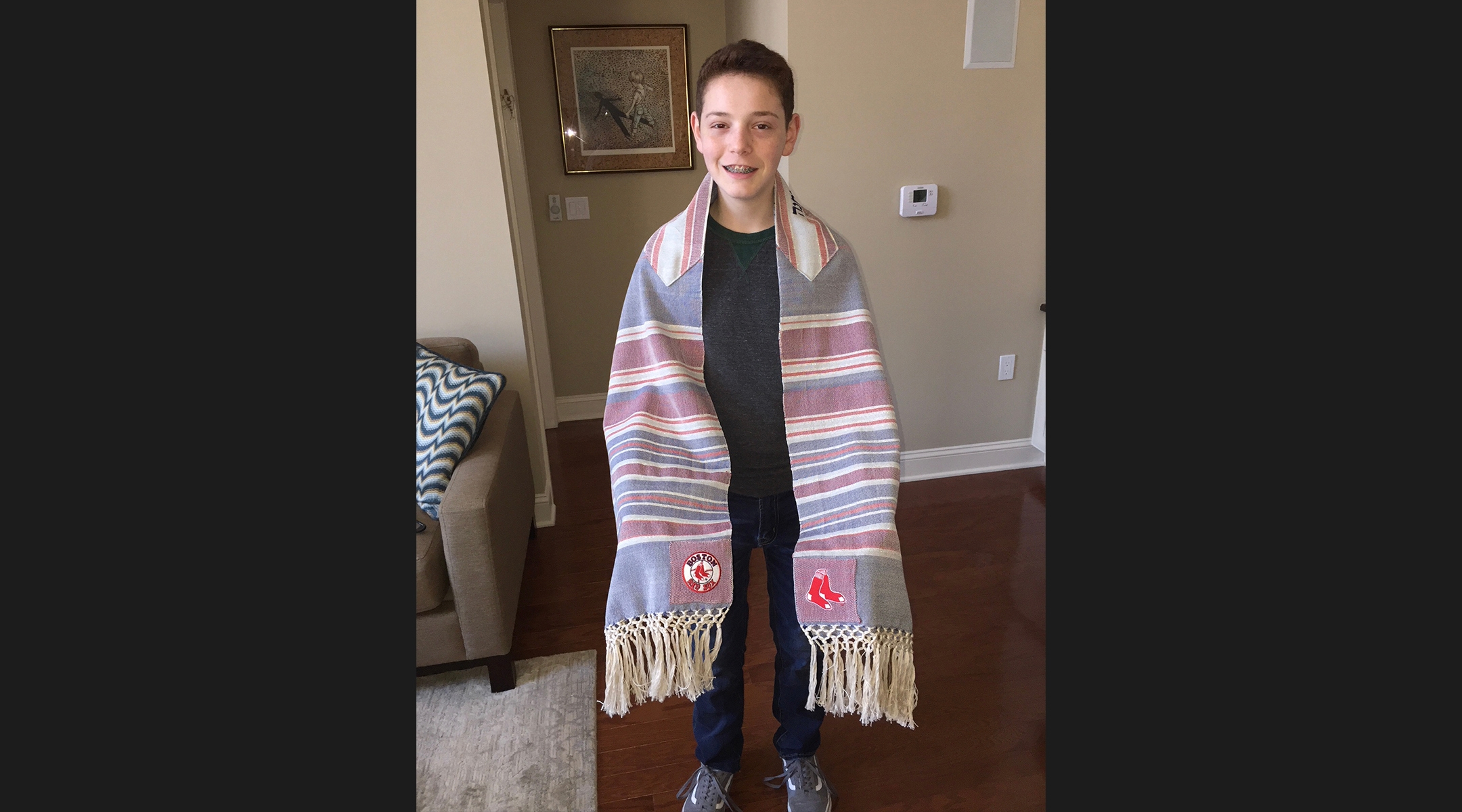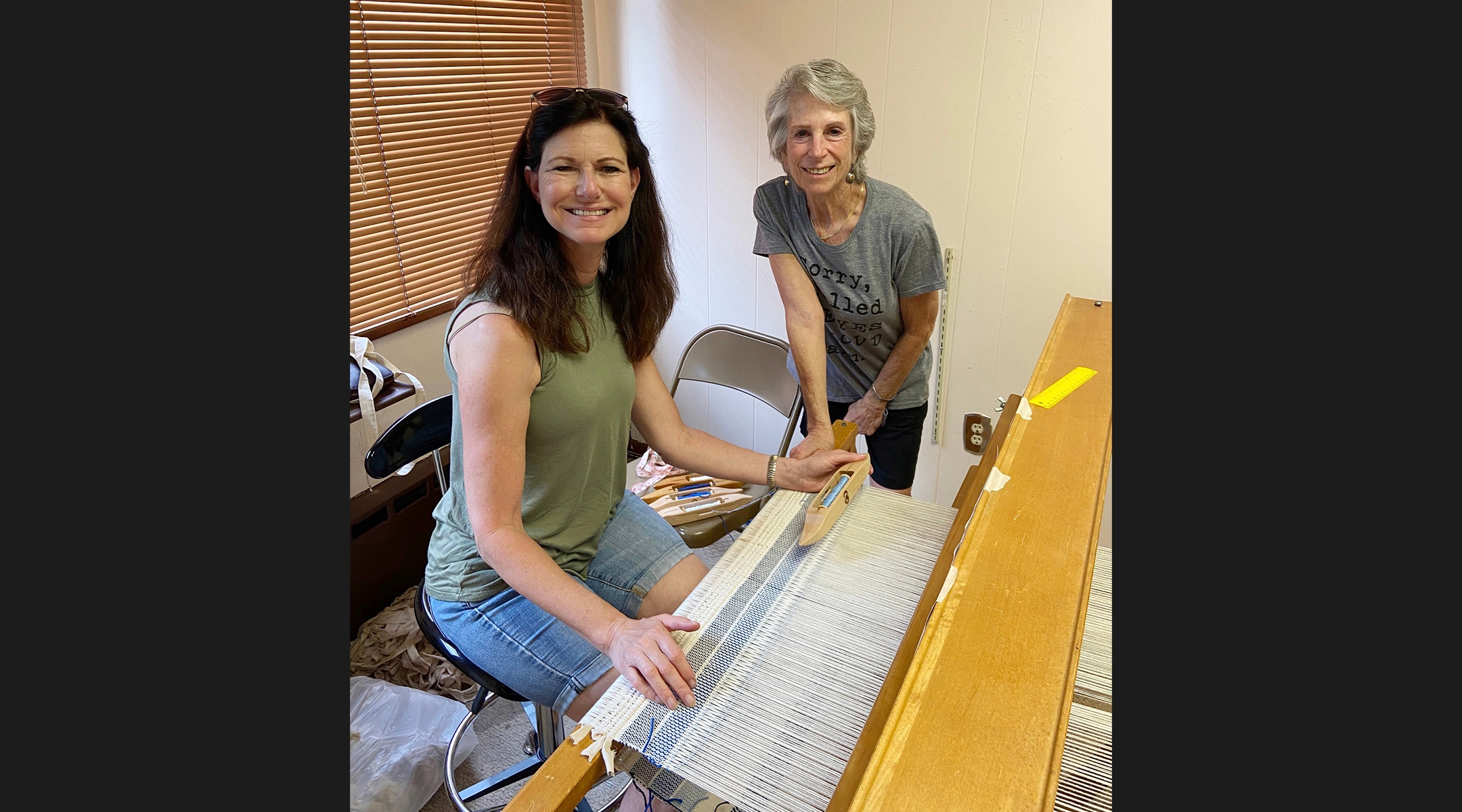Jewish weavers craft their own heritage at this New Jersey synagogue’s ‘Loom Room’
The do-it-yourself spirit of Congregation Neve Shalom echoes the hands-on Judaism movement of the 1970s

Congregants and visitors can weave their own religious garments at Neve Shalom, a Conservative synagogue in Metuchen, N.J.
(JTA) — Some farms allow visitors to pick their own fruit. Some franchises let you make your own pizza.
At a synagogue in New Jersey, you can make your prayer shawl and other woven Judaica items, drawing on an ethos that the most meaningful religious pieces are created by family members and friends.
Neve Shalom, a Conservative synagogue in Metuchen, opened its Sisterhood Loom Room in 2015, offering equipment and instruction for congregants and an increasing number of visitors who want to weave a custom tallit — the familiar prayer shawls with knotted fringes, or tzitzit, attached to their four corners. The shawls, plus tallit bags, challah and matzah covers, frequently become gifts for bar and bat mitzvahs, weddings and other joyous life cycle events.
“If somebody weaves a tallit for you, or they participated in its design – something that’s hand-made – it’s like being hugged by them every time you put it on,” said Cory Schneider, co-creator of the Loom Room with Neve Shalom Sisterhood president Jennifer Bullock.
More than 300 Judaica items have been woven at the Loom Room. Weavers range in age from 4 to 92, and experience levels go from beginner to expert.
Weavers are not only Neve Shalom congregants, but also visitors, largely from eastern Pennsylvania, New York, and Connecticut. Intrepid weavers have ventured from as far as Florida, Las Vegas and Canada, Schneider said.
The effort has grown in popularity since Schneider and her husband moved from Harrisburg, Pennsylvania, to Somerset, New Jersey in 2014. Their granddaughter requested a custom tallit for her upcoming bat mitzvah, and Schneider introduced weaving to the congregation. Schneider came across an unused loom in the garage of a neighbor, a charitable-minded non-Jewish woman who soon donated it to the synagogue.
Bullock, Neve Shalom’s longtime Sisterhood president, was intrigued, and jumped in to learn how to weave.
“I went from being a complete novice to, in short order, being an expert on the loom,” Bullock said.
The woven Judaica items that have since proliferated at Neve Shalom reflect a combination of religious ritual, art and design. Each tallit’s tzitzit — which the Loom Room imports from Israel — must have four strings, intricately knotted according to prescribed instructions. Weavers must also be mindful of the biblical prohibition about mixing wool and linen, or shatnez.
After that weavers have wide latitude on tallit design. One Neve Shalom visitor, Jared Laff, for his 2018 bar mitzvah at Congregation Beth El in Yardley, Pennsylvania, wore a tallit that included the Boston Red Sox insignia. The color scheme and pattern were designed by Laff, and the garment woven by Schneider.
“None of them are alike. No two are identical,” Bullock said. “Each person puts their own identity into it.”

The do-it-yourself spirit of the Loom Room echoes the hands-on Judaism movement of the 1970s, when Jews adjacent to the counterculture began making their own Judaica according to the principle of “hiddur mitzvah,” or beautifying the commandments. “We cheat ourselves if we don’t invest something of ourselves in making beautiful objects for everyday use,” according to one contributor to “The Jewish Catalog,” published in 1973, which included instructions for making a tallit, homemade candles and mezuzahs.
That impulse inspired Deborah Lamensdorf Jacobs to seek out the Loom Room. Lamensdorf Jacobs’ family owns a farm in the Mississippi Delta, purchased by her great-grandfather Morris Grundfest in 1919. Since 2005 she has had prayer shawls made by fellow Atlantan Lynn Hirsch, from cotton grown and baled on the farm.
“We have this first piece of cotton land that he purchased in 1919,” Lamensdorf Jacobs recalled. “But we don’t have the Judaica that we would hope to have had.”
Hirsch had woven the shawls for the bar and bat mitzvahs of her own three children, along with a niece. She started a home business, specializing in prayer shawls and challah covers.
Hirsch eventually sold the loom when she and her husband downsized, leaving Lamensdorf Jacobs without a weaver for several years. Last year, in an internet search, she discovered the thriving Neve Shalom Sisterhood Loom Room, which had just obtained a second loom donated by congregant Deborah Berman.

Lamensdorf Jacobs eagerly shipped cotton-based yarn to New Jersey, to create another family tallit and a challah cover, with Schneider doing the weaving. That’s when Hirsch reentered the picture, helping Lamensdorf Jacobs with pattern designs. Jewish geography being what it is, the Neve Shalom weaving opportunities reconnected Hirsch, formerly of Lebanon, Pennsylvania, and Schneider, a longtime Harrisburg resident, about 34 miles away. They had been active together years before in the Women’s League for Conservative Judaism.
Now at Neve Shalom’s Sisterhood Loom Room, requests to learn weaving are growing at a steady clip.
“They make it accessible. They show you how to do it. They watch you for a little bit and are very patient if you make mistakes,” said Lamensdorf Jacobs, who last year visited Neve Shalom.
It’s been particularly gratifying to watch the weaving program grow in popularity not just among congregants but members of the Jewish community in and around New Jersey, and further away, said Bullock, the Neve Shalom Sisterhood president.
“The program has very much been a labor of love,” Bullock said. “We’re helping people to create Jewish heirlooms for their family, their loved ones, which hopefully will get passed on.”
This article originally appeared on JTA.org.




















